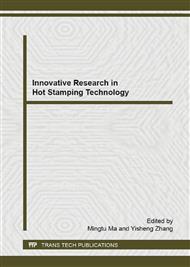p.143
p.151
p.169
p.177
p.181
p.186
p.190
p.194
p.198
Hot Stamping High Strength Steel Spot Welding Technology and Quality Evaluation of Welding Joint
Abstract:
The heterogeneity of microstructure and mechanical performance of welding joints were affected by unique material properties such as high resistivity and low thermal conductivity, instantaneous high temperature of spot welding thermal cycle, and uneven local cooling rate. Because of ultra high strength of hot stamping parts, the welding joint is more inclined to fail as the failure mode of interfacial fracture, the traditional critical nugget formula fell down. Through designing orthogonal experiment, the effect of different welding parameters on joint performance was analyzed, the optimized welding process was obtained; on account of the quality evaluation of welding joint, nugget spherical mode was built to separately analyze the stress condition of welding joint in the failure modes of interfacial fracture and nugget pull-out, the new evaluation criterion aimed at high strength steel was established. Two kinds of 1.2 mm and 2.0 mm steels were used to validate the critical weld diameter. Results showed that the critical formula could accurately evaluate failure of the weld joints.
Info:
Periodical:
Pages:
181-185
Citation:
Online since:
December 2014
Authors:
Price:
Сopyright:
© 2015 Trans Tech Publications Ltd. All Rights Reserved
Share:
Citation:


